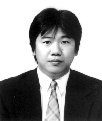

|
Hiroki Konaka
TRC Massively Parallel
Software Laboratory |
Profile
| Affiliation: |
Massively Parallel Software Laboratory, Massively Parallel Department,
Tsukuba Research Center, RWCP |
| Date of birth: |
July 16, 1964 |
| Birthplace: |
Hyogo |
| Background: |
|
| 1987 |
Graduated from the Electronic Engineering Department, Faculty of
Engineering, University of Tokyo. |
| 1989 |
Completed the Master Course of Electric Engineering, Postgraduate
School of Engineering, University of Tokyo. |
| 1989 |
Joined Mitsubishi Electric Corporation. |
| 1992 |
On loan to the Real World Computing Partnership |
| Hobbies: |
Golf, playing musical instruments. |
It is almost four years since I came here to join the Tsukuba Research
Center. At first, I didn't know much about this city, except the section
surrounded by the main streets that run north to south and west to east.
But I've recently found many interesting spots and things in the community
and its neighborhood such as very cheap, good quality agricultural products,
a "three-star" Soba noodle restaurant, and an unbelievably cheap golf course.
I have also found a lot of relaxing places within a few hours drive, such
as Kasama and Mashiko, both famous for pottery, hot spa resorts and waterfalls.
It may also be relevant to my research activities here at the TRC. It
was in the spring of 1993 when a research subject started to take shape
in my mind on the theme of a programming language within a parallel object-oriented
framework as the infrastructure of research on massively parallel programming
models. When I was a university student, I developed a music information
processing system and the type inference systems for an object-oriented
logic programming language and a concurrent logic programming language.
After joining Mitsubishi Electric Corporation, I programmed neural networks
and other things; I was always a user of programming languages. When I started
my new research here at the TRC, I had an image of the language I'd like
to develop, but I didn't have even a basic knowledge of language processing
systems. I had to start learning from scratch, so I could not afford to
look around new language. The new language was soon named "OCore" for some
reasons. OCore is pronounced as "O KOWA," and its meaning is "fearsome"
in a dialect of the Western area of Japan. So, the development of OCore
was launched with a sense of uncertainty while whispering "OCore".
Eventually, in December 1993, a small language processing system finally
began running on a Paragon machine although it contained a number of bugs.
At the same time, some parallel applications started to run. Around that
time, I began to see an environment around the OCore language from machines
to applications. Since then, many improvements and modifications have been
made to the language with much support from many colleagues, including Mr.
Maeda and Mr. Tomokiyo of the Massively Parallel Software Laboratory, and
some application programs finally ran on several machines. The speech recognition
program of the Information Integration Laboratory is a good example; it
gave me an unexpected pleasure of achievement when such applications that
I hadn't even conceived of at the start finally ran on actual machines.
I will continue to improve and modify OCore so that parallel applications
that other conventional parallel programming languages cannot handle can
be run on computers. In addition, I will work on description of parallel
application programs that are closer to human processing such as speech
recognition.

